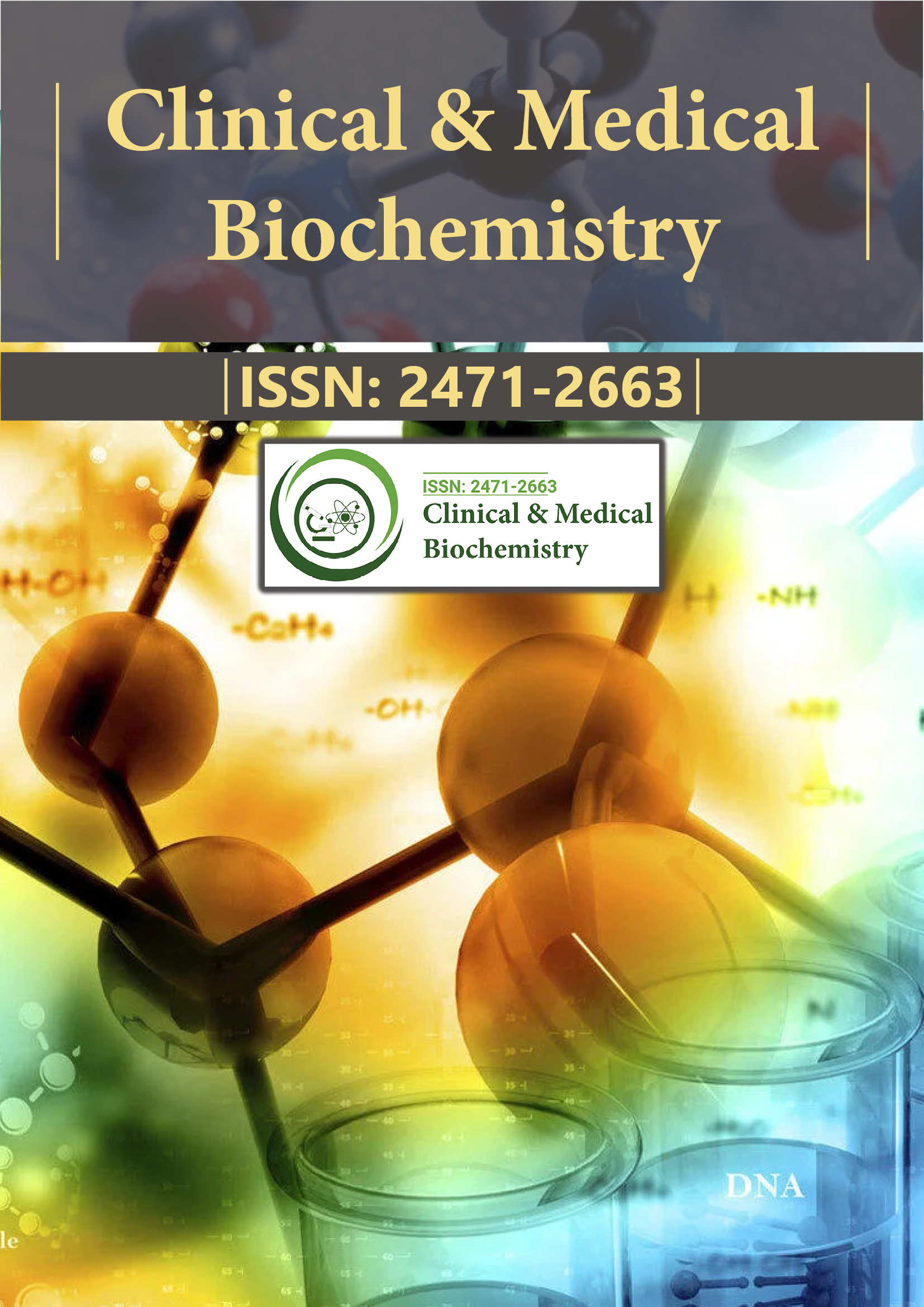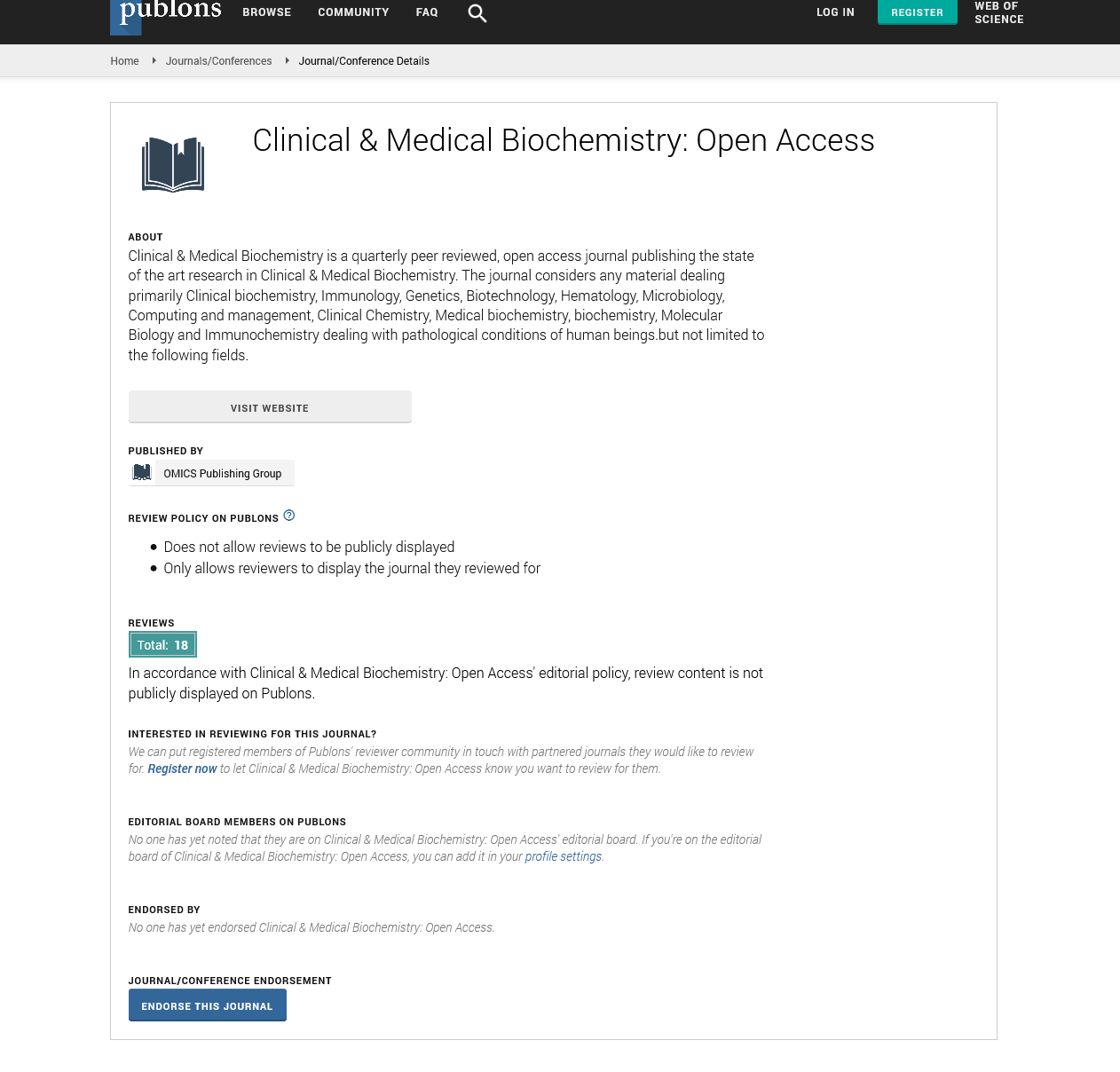Indexed In
- RefSeek
- Directory of Research Journal Indexing (DRJI)
- Hamdard University
- EBSCO A-Z
- OCLC- WorldCat
- Scholarsteer
- Publons
- Euro Pub
- Google Scholar
Useful Links
Share This Page
Journal Flyer

Open Access Journals
- Agri and Aquaculture
- Biochemistry
- Bioinformatics & Systems Biology
- Business & Management
- Chemistry
- Clinical Sciences
- Engineering
- Food & Nutrition
- General Science
- Genetics & Molecular Biology
- Immunology & Microbiology
- Medical Sciences
- Neuroscience & Psychology
- Nursing & Health Care
- Pharmaceutical Sciences
Perspective - (2023) Volume 9, Issue 2
General Perspective of Copper Binding Proteins in Parkinsonâs Disease
Samuel Bussard*Received: 03-Mar-2023, Manuscript No. CMBO-23-20541; Editor assigned: 06-Mar-2023, Pre QC No. CMBO-23-20541 (PQ); Reviewed: 20-Mar-2023, QC No. CMBO-23-20541; Revised: 27-Mar-2023, Manuscript No. CMBO-23-20541 (R); Published: 03-Apr-2023, DOI: 10.35841/2471-2663.23.9.154
Description
Parkinson's disease is the second most prevalent neurodegenerative disorder and a major portion of the global population is affected by this age-related chronic ailment. Parkinson's disease is clinically distinguished by four key symptoms: tremor at rest, rigidity of the muscles, bradykinesia or akinesia, and alterations in posture. Tremor typically starts off unilaterally before becoming bilateral. Although tremors in the hands are typically the first to be noticed, tremors in the face are as frequently seen when motor symptoms spread distally. Patients often have trouble walking, and they run the risk of falling due of their postural instability. This collection of symptoms as a whole causes dependency and incapacity. Longterm dependence on others for activities of daily living like dressing or feeding lowers the quality of life for Parkinson's disease sufferers, who also have a significantly reduced quality of life. Parkinson's disease patients have very significant and crippling non-motor symptoms in addition to altered movement, including autonomic dysfunction, cognitive abnormalities, sleep difficulties, mood disorders, pain, and sensory impairments. The loss of dopamine-producing neurons, whose cell bodies are found in the substantia nigra pars compacta, as well as the presence of Lewy bodies, clumps of misfolded proteins and other substances, are the primary pathogenic features of Parkinson's disease.
Due to the fact that the dopaminergic cells in this area project terminals to the caudate/putamen nuclei, cell loss results in a decreased dopamine concentration in the basal ganglia, which causes the motor symptoms seen in patients. The causes of Parkinson's disease remain unknown in the great majority of instances, and the ailment is thought to be multifactorial even though a sizable fraction of cases are connected to genetic abnormalities. Alterations in transition metal storage, transport, and cellular handling have received attention in neurodegenerative illnesses, particularly after early postmortem findings revealed iron accumulation and decreasing copper levels in Parkinson's disease patients' brains. This discovery is particularly significant since, as a result of their redox characteristics, both metals are involved in the production and spread of free radicals as well as in protein precipitation. In addition to the aforementioned mechanism of damage, copper is a particular example since it is a cofactor of antioxidant enzymes like ceruloplasmin and Cu/Zn-SOD. The study of neurodegenerative illnesses is made fascinating by the dual nature of copper. There are numerous copper-dependent enzymes and copper-binding proteins known to exist.
Alpha-synuclein is a protein of uncertain function that is abundant at the presynaptic terminals of numerous neurons. Parkinson's disease and other neurodegenerative conditions like dementia with Lewy bodies, multiple system atrophy, and Alzheimer's disease are all significantly linked to alpha-synuclein. Lewy bodies, which are intracellular protein clusters that are particularly high in filamentous alpha-synuclein, are the hallmark of all of these disorders. Both Parkinson's sufferers and healthy people have alpha-synuclein in their plasma and cerebrospinal fluid. The ubiquitin-proteasome system, which is dysfunctional in patients with idiopathic forms of the disease, catabolizes alpha-synuclein in the cell in a healthy manner. The ubiquitin-proteasome system becomes dysfunctional due to alpha-synuclein accumulation. Ceruloplasmin is a multicoppercontaining glycoprotein that is mostly biosynthesized in the liver. The liver releases ceruloplasmin that has been coupled to copper during the early stages of its synthesis in the secretory route, along with the inclusion of a polysaccharide moiety. Ceruloplasmin performs a number of different functions, including those of an iron oxidase, copper transporter, amine oxidase, antioxidant, anti-inflammatory, nitric oxide oxidase, and glutathione peroxidase.
Ceruloplasmin has two main purposes: (a) binding plasma copper (95% of the circulating copper is bound to ceruloplasmin); and (b) maintaining iron homeostasis through its ferroxidase activity, which has consequences for the regulation of free radical synthesis. Utilizing the rodent model of Parkinson's disease generated by MPP+ (1-methyl-4-phenylpyridinium) intrastriatal injection, our group demonstrated that the administration of CuSO4 (10 mol/kg) as a pretreatment 24 h before the lesion prevented protein nitration, TH inactivation, and dopamine depletion and lowered the activity of constitutive nitric oxide synthase (cNOS) in the striatum. Copper may counteract NMDA receptor responses by limiting Ca2+ influx and thus Ca2+-dependent NOS activation, reducing protein nitration. Pretreatment with copper boosted ceruloplasmin expression and reduced MPP+- induced loss of ceruloplasmin ferroxidase activity and lipid peroxidation. In addition, there was a modest decrease in ferrous iron in the striatum and mesencephalon. Enhanced ferroxidase activity is responsible for the reduction in ferrous iron content as well as the avoidance of lipid peroxidation. As a result, copper-induced ceruloplasmin expression could be used as an experimental technique to counteract the harmful effects of iron deposits in Parkinson's disease.
The use of the hypoxic imaging agent Cu(II) (atsm) in four different models of Parkinson's disease has been demonstrated to be neuroprotective via numerous mechanisms, including the prevention of alpha-synuclein nitration and fibrillation. The copper compound also demonstrated TH immunostaining protection of dopamine-producing neurons, as well as motor function preservation and reduced cognitive deterioration. Pretreatment with EGb761 (an extract of the Ginkgo biloba tree) prevents MPP+'s neurotoxic actions; some of the extract's protective actions can be related to the reversal of MPP+- induced copper depletion in the striatum of rats and the modulation of copper homeostasis in other brain regions. Copper chelation may be beneficial in the treatment of certain neurodegenerative illnesses, such as Parkinson's disease. rTMS has been used to treat the clinical signs of Parkinson's disease with moderate effectiveness, leading in increased motor performance, blood dopamine elevation, and enhanced smell and taste abilities.
Citation: Bussard S (2023) General Perspective of Copper Binding Proteins in Parkinson’s Disease. Clin Med Bio Chem. 9:154.
Copyright: © 2023 Bussard S. This is an open-access article distributed under the terms of the Creative Commons Attribution License, which permits unrestricted use, distribution, and reproduction in any medium, provided the original author and source are credited.

